
Boronia molloyae, commonly called the tall boronia, is a plant in the citrus family that is endemic to coastal regions in the south-west of Western Australia. It is a shrub with pinnate leaves that mostly have between three and seven leaflets, and deep rose pink, four-petalled flowers. It usually grows along streams in sandy soil.

Boronia jucunda is a plant in the citrus family Rutaceae and is endemic to the far north-west of Australia. It is an erect shrub with many branches, pinnate leaves and white, four-petalled flowers. It is only known from a small area in the Kimberley region in Western Australia and in a national park in the Northern Territory.
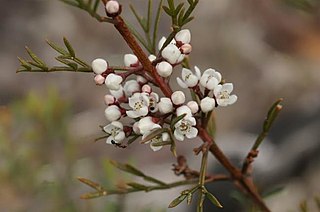
Boronia occidentalis, commonly known as the rock boronia, is a plant in the citrus family Rutaceae and is endemic to eastern Australia. It is an erect, woody shrub with pinnate or bipinnate leaves and groups of up to three white to pale pink, pink four-petalled flowers arranged in leaf axils.

Boronia warrumbunglensis is a plant in the citrus family Rutaceae and is endemic to a small area in the central west of New South Wales. It is a shrub with many branches, pinnate leaves and one or two pink, four-petalled flowers in the leaf axils. It is only known from the Warrumbungles and nearby districts.
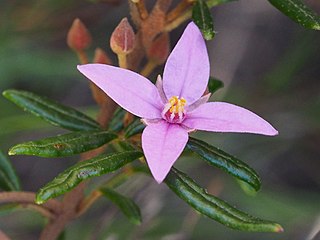
Boronia angustisepala is a plant in the citrus family Rutaceae and is endemic to New South Wales, Australia. It is an erect shrub with many branches, pinnate leaves with up to eleven leaflets, and bright pink, four-petalled flowers.
Boronia anomala is a plant in the citrus family Rutaceae and is only known from a single population growing under an overhang in a sandstone gorge in the Kimberley Australia region of Western Australia. It is an erect, mostly hairless shrub with pinnate leaves and four-petalled flowers.
Boronia barrettiorum is a plant in the citrus family Rutaceae and is only known from two populations growing north of the Prince Regent River in the Kimberley Australia region of Western Australia. It is an erect, open shrub with hairy branches and leaves, simple or trifoliate leaves and white, four-petalled flowers.
Boronia citrata, commonly known as lemon boronia, is a plant in the citrus family, Rutaceae and is endemic to Victoria. It is an erect, woody shrub with pinnate, strongly lemon-scented leaves and pale pink to rosy pink, four-petalled flowers arranged in groups of up to five.
Boronia cremnophila, commonly known as the Kimberley cliff boronia, is a plant in the citrus family, Rutaceae and is endemic to a small area in the Kimberley region of Western Australia. It is an erect or spreading shrub with both simple, and trifoliate leaves, and white sepals and petals, the sepals larger than the petals.

Boronia decumbens is a plant in the citrus family Rutaceae and is endemic to northern parts of the Northern Territory. It is a low, spreading shrub with pinnate leaves and white to pink flowers with the four sepals larger than the four petals.

Boronia filicifolia is a plant in the citrus family, Rutaceae and is endemic to the far north-west of Australia. It is an erect or sprawling shrub with many branches, pinnate leaves with up to 55 leaflets and white to pink flowers with the sepals a similar length to the petals.
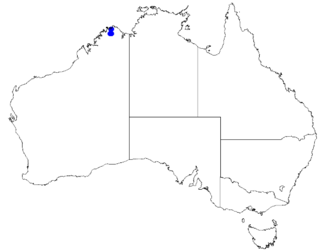
Boronia kalumburuensis is a plant in the citrus family Rutaceae and is endemic to the Kalumburu area of Western Australia. It is an erect or sprawling shrub with many branches, pinnate leaves and white to pink four-petalled flowers with the sepals longer and wider than the petals.
Boronia minutipinna is a plant in the citrus family Rutaceae and is endemic to a small area in the Kimberley region of Western Australia. It is an erect shrub with many branches, hairy stems and leaves, pinnate leaves and white to pink, four-petalled flowers with the sepals longer and wider than the petals.

Boronia pauciflora is a plant in the citrus family Rutaceae and is endemic to the Kimberley region of Western Australia. It is an erect shrub usually with simple leaves and white to pink, four-petalled flowers.
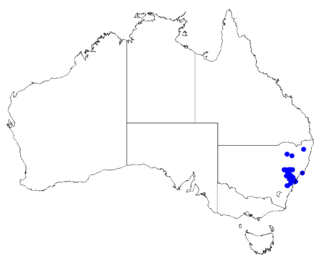
Boronia rubiginosa is a plant in the citrus family Rutaceae and is endemic to New South Wales in Australia. It is a shrub with pinnate leaves that are paler on the lower surface, and up to three pale to bright pink, four-petalled flowers in the leaf axils.
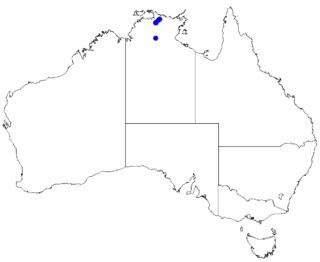
Boronia rupicola is a species of plant in the citrus family Rutaceae and is endemic to a small area in the Northern Territory, Australia. It is a small shrub with weeping branches, simple or pinnate leaves and small, green, inconspicuous flowers.
Boronia thedae, commonly known as the Theda boronia, is a plant in the citrus family, Rutaceae and is endemic to a small area in the Kimberley region of Western Australia. It is an erect shrub when young, later a prostrate shrub with many branches, pinnate leaves, four white to cream-coloured or pale pink sepals and four similarly coloured petals, the sepals longer and wider than the petals.

Boronia tolerans is a plant in the citrus family, Rutaceae and is endemic to a small area in the Northern Territory in Australia. It is an erect shrub with many branches, pinnate leaves and white, four-petalled flowers. It is only known from Nitmiluk National Park.

Boronia wilsonii is an erect shrub that is endemic to northern Australia. Its branches, leaves and backs of the flowers are densely covered with woolly hairs. The petals are white to pink or burgundy-coloured.
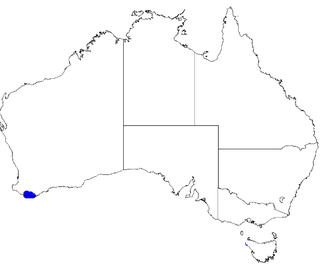
Boronia virgata is a plant in the citrus family, Rutaceae and is endemic to the south coast of Western Australia. It is a virgate shrub with pinnate leaves with between three and five leaflets, and flowers with red sepals and deep pink, egg-shaped petals.














